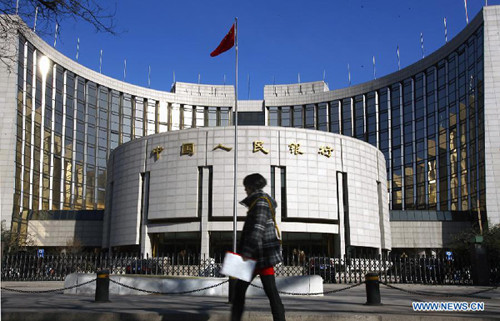
A file photo taken on Feb. 23, 2012 shows a pedestrian walking past the headquarters building of the People's Bank of China in Beijing, capital of China. (File photo)
The People's Bank of China, the country's central bank, together with other financial regulators, released a financial reform plan for the 12th Five-Year Plan period (2011-2015).
The plan includes reforms regarding the marketization of exchange and interest rates and the convertibility of the yuan under China's capital account.
The liberalization of interest rates will be pushed forward progressively and reforms of the mechanism used to calculate the yuan's exchange rate will occur steadily, the plan states.
Authorities will allow freer cross-border capital flow and boost the convertibility of the yuan under China's capital account, according to the plan.
Authorities will encourage private capital to participate in the reform of banks, securities firms and insurance companies, as well as guide private capital to expand investment in financial organizations, the plan states, adding that the government also supports private capital in setting up rural banks, credit companies and capital cooperatives.
By specifying the guiding principle and major targets and tasks in pressing ahead with the financial reform between 2011 and 2015, the blueprint, experts say, is of great significance for improving the financial system and promoting the healthy development of the financial industry.
China has confronted more challenges in its financial macro-regulation over the past two years as the external environment became more complicated due to the global financial crisis.
Therefore, such a blueprint was released just in time to help China's financial sector adjust to the changes in the environment, seize the development trend, mitigate risks and open up a new chapter in its development and reform, said Zhang Yansheng, secretary-general of the Academic Committee of the National Development and Reform Commission (NDRC).
China's real economy has been increasing slowly in recent years. According to a report about the top 500 Chinese enterprises released by the China Enterprise Confederation, the combined profit of 272 manufacturing companies accounts for 25.04 of the total, the lowest level in five years.
This not only makes people more concerned about the "hollowed" real economy, but also brings more challenges to the closely-related financial industry.
The plan reiterated that the financial industry should serve the real economy by requiring funds go to the real economy in order to prevent industries from becoming hollowed.
Zhang Yansheng said that financial reform, as the key link and sector in the new round of reform and opening up, plays an important role in the transformation and upgrading of China's real economy.
The plan will help the financial sector take root in the real economy, which will in turn further facilitate the financial reform and guard against risks.
The plan also calls for more efforts to support technological innovations and economic restructuring. The growth rate of loans extended to agriculture, farmers and rural areas, and small- and micro-sized enterprises should exceed the average growth rate of total loans.
By 2015, the value-added output of the nation's financial industry will account for 5 percent of the gross domestic product (GDP), while the value of direct financing by non-financial organizations will account for at least 15 percent of the total social financing value, according to the plan.
To achieve the above two quantitative targets, a multi-layer capital market will be in place to help all kinds of enterprises raise funds, according to industry insiders.
Moreover, experts say the plan draws the outline of the framework of future monetary policies.
Lu Zhengwei, chief economist at Industrial Bank, noted that the ultimate goal of economic development shifts from striking a balance between keeping prices stable and maintaining growth to keeping prices basically stable in a broader sense.
Keeping prices stable will, in the long term, help achieve sound economic development, experts say.
Meanwhile, the relationship among keeping stable and relatively fast economic development, managing inflation expectation and adjusting economic structure should be handled properly, according to the plan.
Apart from traditional intermediate objectives like money supply and new loans, social financing will also be taken into consideration in drawing up monetary policies.

Copyright ©1999-2011 Chinanews.com. All rights reserved.
Reproduction in whole or in part without permission is prohibited.